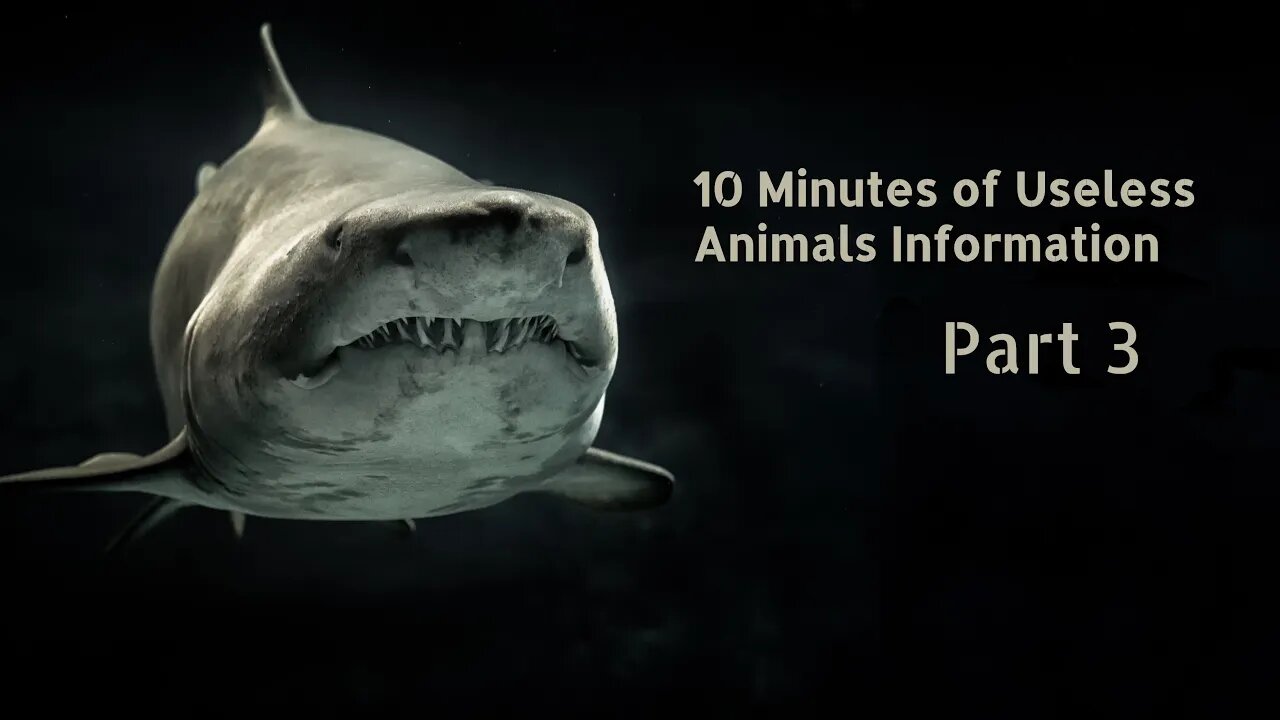Premium Only Content

10 Minutes Of Useless Animals Information Pt3
From Bears to Octopus and Sharks, Here are 10 mins of mind blowing yet useless information to keep you entertained!
Presenting to you 10 mins of useless animals information - filled with fun facts about seahorse, lions, opossums, sharks and many more!
This video is filled with animal information and animal facts you didn't know !
Hope you enjoyed this video,
Many more amazing animals videos on this channel, Hit the subscribe button to stay tuned.
Hey there, welcome to yet another series on 10 mins of useless animals information
There are an estimated 8.7 million species on earth and more than 80% of them remains undiscovered.
However among the ones we do know, there are many that would suprise you .. like the
Giant tortoise from the Galápagos Islands, these tortoises can weigh up to 550lbs – the same as a brown bear!
and if you think that's massive, wait until you hear about the giant squid. The biggest invertebrate on Earth, with a length of over 40ft, equivalent
to the length of a full bus also it's got eyes the size of a dinner plates.
speaking of eyes An ostrich's eye is bigger than its brain.
Not saying the bird is dumb but in a way it's actually ... ahh ... really dumb
for when faced with an imposing threat, the ostrich will push its head at the ground, close its eyes and go invisible. Well, at least the bird thinks it’s invisible.
on the contrary when it comes to pigs, whom people generally think of dirty and dumb for their mucky appearance gives pigs an undeserved reputation for slovenliness. Whereas In fact, pigs are some of the cleanest animals around, refusing to excrete anywhere near their living or eating areas when given a choice. Pigs are also one of the most intelligent non-human animals that is after chimpanzees, dolphins, and elephants.
Pigs are as well way smarter than dogs... although dogs hold a special place in our hearts.
Dogs are know for being man's best friend, and that's a relationship that goes back longer than you might expect. According to Guinness World Records, the oldest known breed of domesticated dog goes all the way back to 329 BC. "Saluki dogs were revered in ancient Egypt, being kept as royal pets and being mummified after death.
Cats have also been hanging around humans for thousands of years. Guinness World Records reports that we've been domesticating cats for 9,500 years. Proof of this came in 2004 when the "bones of a cat were discovered in the neolithic village of Shillourokambos on Cyprus. The position of the cat in the ground was next to the bones of a human, whose similar state of preservation strongly suggests they were buried together."
Moving on to bigger cats, let's talk about The lion
Male lions grow impressive manes the older they get. These manes grow up to 16cm long and are a sign of dominance. The older they get, the darker their manes go.
Although While male lions attract their fair share of attention thanks to their impressive manes, it's the female lions who do the bulk of the work when it comes to feeding their families. Lionesses hunt around 90 percent of the time, while the males protect their pride."
Similarly even when it comes to mosquitos, it's only the female mosquitoes that bite.
Now, this is quite common for a big part of the animal kingdom where the female does the hunting and the male looks after herd or family.
Whereas when it comes to seahorses, they have reversed some roles completely.
It's the male seahorse that goes through pregnancy and gives birth to babies. They are the only animal on earth where the male carries the baby rather than the female.
The male seahorse has a pouch on its stomach in which they carry babies—as many as 2,000 at a time, each about the size of a jelly bean
Newborn blue whales on the other end are big babies! They can reach about 23 feet in length and can weigh 5,000 to 6,000 pounds at birth.
And they grow fast ... Adding about 250 pounds each day which means that the baby blue whale gains over a ton within 20 days.
20 days might not seem like a lot but for a house fly it's almost it's entire life. As a housefly has a lifespan of just 20-30 days.
Btw When you hear a housefly buzzing around your home, you might be annoyed by the persistent sound. However, the next time it happens, try to soothe yourself by noting that the airborne pest is actually buzzing in an F key.
Not sure if they're even interested in music, however cows do enjoy music.
Cows are known to produce more milk when listening to slow music. Maybe it has something to do with the moo-d. Researchers found that cows produced 1.54 more pints per day—a 3 percent increase—when they were played slow music, as opposed to more upbeat tunes.
Many studies support that certain types of music can help dogs as well feel more relaxed.
Hope you enjoyed this video
many more amazing videos on this channel, Hit the subscribe button to stay tuned!
-
 4:44:07
4:44:07
RECON-RAT Guns & Gaming
23 hours ago $12.86 earnedRECON-RAT - Insurgency Sandstorm! - Contact Front!
44K3 -
 LIVE
LIVE
Phyxicx
10 hours agoFortnite/Rocket League Teams! - 12/3/2024
1,608 watching -
 1:30:14
1:30:14
barstoolsports
13 hours agoBarstool Coworkers Compete For Largest Cash Prize Yet | Surviving Barstool S4 Ep. 1
261K18 -
 LIVE
LIVE
SpartakusLIVE
9 hours agoMy BICEPS are NOT photoshopped
2,905 watching -
 1:15:26
1:15:26
Kim Iversen
10 hours agoFinal House COVID-19 Report: Claims Vaccines Were A Disaster But Operation Warp Speed Was a Success...
69.9K116 -
 1:14:19
1:14:19
The Anthony Rogers Show
13 hours agoEpisode 248 - Light Language & Intergalactic Gifts In The Higher Realms
52K5 -
 2:38:12
2:38:12
Tundra Gaming Live
8 hours ago $3.26 earnedThe Worlds Okayest War Thunder Stream
37K1 -
 10:57
10:57
Tactical Advisor
12 hours agoNEW Compact Echelon | Springfield 4.0 C (FIRST LOOK)
72.3K1 -
 1:23:56
1:23:56
Glenn Greenwald
11 hours agoBiden Pardons Hunter After Months Of Vowing He Wouldn't; Plus: Biden's Career Imprisoning Crack Addicts | SYSTEM UPDATE #374
130K132 -
 1:28:16
1:28:16
Barry Cunningham
8 hours agoBANNED ON YOUTUBE SERIES: Inside The Border Crisis! Barry Cunningham Interview With Border Agent
62.4K87